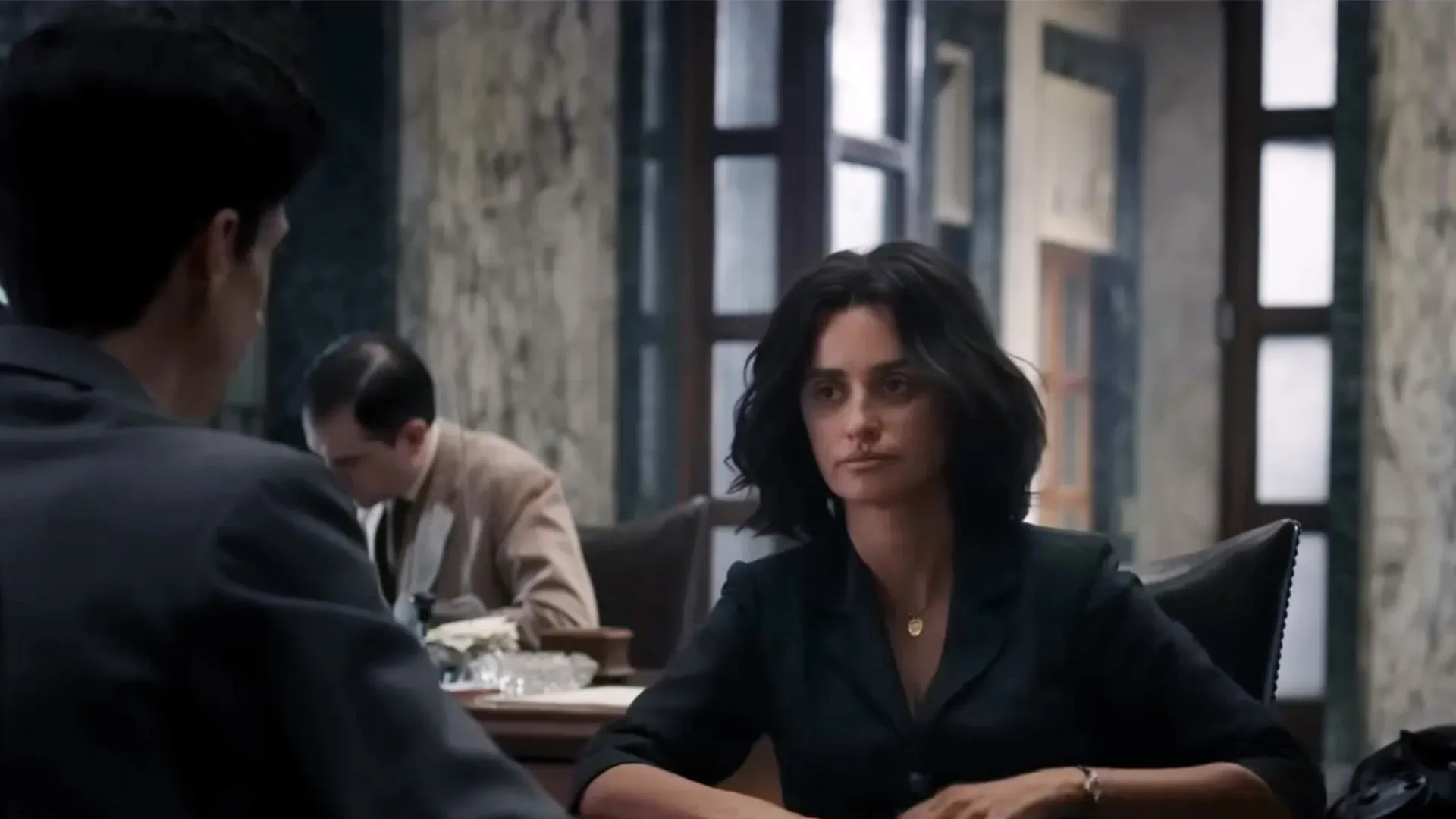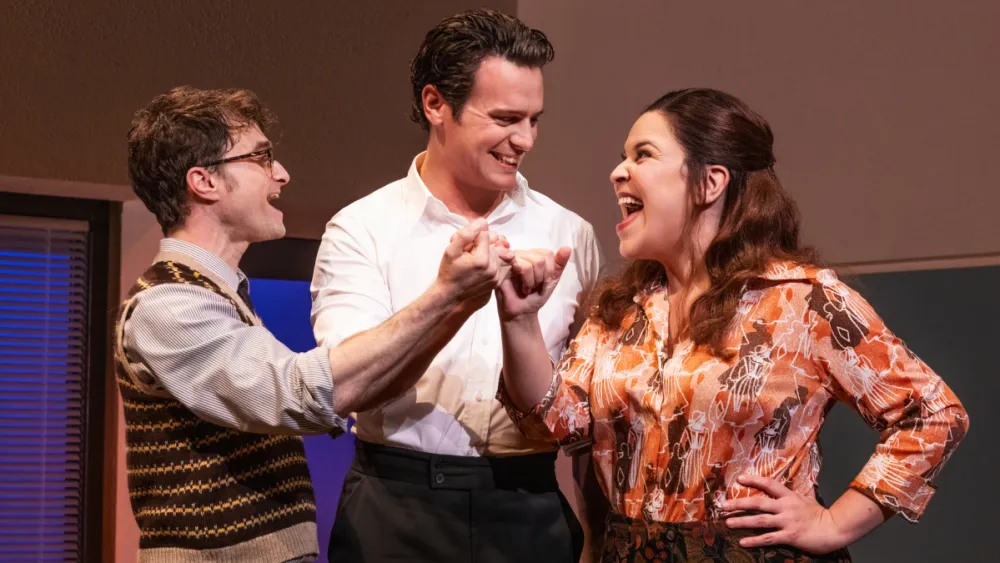What to Watch: Oh, Brother
Ethan Coen's "Drive-Away Dolls" reviewed, "Ferrari" reconsidered, and some thoughts on two Broadway musicals.

Based on the absurdly small sample of the two narrative features they’ve directed on their own, I think we can say with impunity what each of the Coen brothers has brought to the party over 40 years and 18 films. Joel made “The Tragedy of Macbeth” in 2021: Gray, misty, a monument to brutalism in the architectural sense, it’s as serious as movies get and a hint as to where the gravitas that gives “No Country for Old Men,” “A Serious Man,” and “Fargo” their weight. Now comes Ethan’s “Drive-Away Dolls” (⭐ ⭐ 1/2, in theaters) – he made a documentary about Jerry Lee Lewis in 2022 – and it is as antic and silly as the goofiest parts of “Raising Arizona,” “Burn After Reading,” “Hail, Caesar!” and others of the brothers’ most lightweight work. Without Ethan to provide the helium, Joel’s “Macbeth” is grim and stilted; without Joel to provide the ballast, “Dolls” floats away like a soap bubble before popping with a rainbow splat.
That’s the theory, anyway, and I’m sticking with it until proven otherwise. “Drive-Away Dolls” is mostly for Coen die-hards – a bawdy lesbian road comedy seemingly stitched together out of bits from other movies. (What is it with the lesbian buddy films lately? With "Dolls," last year’s “Bottoms,” and the upcoming “Love Lies Bleeding,” we officially have a mini-trend.)
“Drive-Away Dolls” – which apparently was titled “Drive-Away Dykes” until more timid heads in the marketing department prevailed – sticks to the time-honored template of tight-ass and wild card besties, here played respectively by Geraldine Viswanathan as the bookish Marian and Margaret Qualley as motor-mouthed Jamie, who has never had an impulse she didn’t immediately act upon. Qualley borrows the honey-baked Southern accent of her mother, Andie MacDowell, and amps it up to 11 or as close to caricature as you can get without turning actively two-dimensional.

The two rent a drive-away car to take them from Philadelphia to Tallahassee in an effort to break Marian out of her funk; unbeknownst to them, some Bad People have stashed a metallic suitcase in the trunk and want it back. What’s in the suitcase? The movie delays that revelation for the longest time, and I’m certainly not going to tell you, but I can pretty much guarantee it’s not what you think.
Which may be the only real surprise in “Drive-Away Dolls,” other than the flashback cameo by a recent Grammy winner as a 1960s artiste working in a very specific medium. A certain A-list Coen alumnus has an amusing turn in the final act, Beanie Feldstein works hard in the role of Jamie’s spurned cop lover, and Bill Camp underplays to pleasant effect as a much-abused rental company owner. But Joey Slotnick and C.J. Wilson as the two hired goons chasing after our heroines – one overly chatty and the other overly mean – are a roadshow version of Steve Buscemi and Peter Stormare in “Fargo,” and the hoped-for air of lubriciously daring wackiness mostly curdles on the screen. I do like the names of the lesbian bars Jamie and Marian visit, though – The Butter Churn, The She Shed – and the college women’s soccer team snogging away in a suburban rec room is a cheerful sight. Coen co-wrote the movie with his wife of three decades, Tricia Cooke, who’s lesbian and with whom he has an open relationship; whatever, if it works for them, great. It’s relevant only in that the two decided, per Ethan in a recent interview, that “there was an underserved community that needed a dumb gay movie.” Which – fair enough – is what they’ve delivered.

Having finally caught up with “Ferrari” (⭐ ⭐ ⭐, for premium rental on Amazon, Apple TV, YouTube, and elsewhere), I’m a little surprised that the Michael Mann biopic about Italian automaker Enzo Ferrari has been largely overlooked by audiences, critics’ groups, and awards-season nominators. There’s been carping that Penélope Cruz was ignored in acting categories for her portrayal of Enzo’s seething, cast-aside wife Laura Ferrari, and Cruz is certainly worth the price of admission, even at current $19.99 premium VOD prices. (Wait a month or two if you'd prefer the $5.99 special.) But while cast members like Shailene Woodley (as Enzo’s mistress Lina Lardi) and Patrick Dempsey (as veteran race-car driver Piero Taruffi) never convincingly shake their Americanness, Adam Driver is superb in the lead – icily controlled on the surface while suggesting the guilt, arrogance, and despair that pushes Ferrari to risk his company survival and his drivers’ lives.
In some critical quarters, the star was accused of playing it too close to the vest and refusing to give the audience emotional traction, but that’s kind of the point of the character and the movie, isn’t it? That all the fury Ferrari can’t bring himself to unleash on a world that killed his brother and his son – while sparing his viper-tongued mother (a splendid Daniela Piperno) – has been channeled into a need for dominance and speed on his terms and no one else’s. Which makes a mid-movie meeting with an acquisitions-hungry Fiat CEO all the more ironic; during the screening, a friend reminded me of the old joke that Fiat is an acronym for “Fix It Again, Tony.”
Anyway, it’s a Michael Mann movie, as cool and contained as the hero it admires. Mann has always struck me as an heir to Howard Hawks in his devotion to the idea that a man is defined by the job in front of him and talking about it just gets in the way. What keeps him from true greatness – and many of my colleagues would disagree (especially Vulture film critic Bilge Ebiri) – is that Mann is not remotely interested in the other half of the Hawksian worldview, which is that chaos exists, it’s female, and it’s comedy. Chaos exists in “Ferrari,” but it’s the chaos of what happens when the wheels come off, and it’s terrifying: Mann’s brilliant staging of Alfonso de Portago’s crash during the 1957 Mille Miglia, which killed seven spectators, five of them children, is a moment of movie horror I won’t soon forget.

The film exemplifies seriousness of purpose – both its maker’s and its subject’s – without ever turning pretentious, and that’s something. Meticulously directed, with visual shadings to match its moral complexity (Erik Messerschmidt was the cinematographer), “Ferrari” is more character study than densely plotted narrative, but don’t let that put you off. It’s a high-minded, high-end version of the brand-identity biopics we’ve been getting in recent years – “Blackberry” and “Air” and “Tetris” and even “Ford v Ferrari,” which takes place a few years after the events of Mann’s film and in which Enzo (Remo Girone) is a sly old fox who’s seen it all. “Ferrari,” by contrast, tells the story of how he saw it.

Totally off-topic, but Mrs. Movie Critic and I took a weekend in New York to visit relatives and see some shows, one of which was Sondheim and another of which was not. The one that was not was the much-praised, Tony-winning “Hadestown,” Anäis Mitchell’s bayou retelling of the Orpheus and Eurydice myth. It’s been running on Broadway since 2019 – and had a long gestation before that, including a 2010 concept-album version – which I guess has been long enough for the show, or its current Orpheus, Jordan Fisher, to attract a devoted repeat audience of young women, who loudly cheered every song with insider enthusiasm. Which, to an outsider, was a little disconcerting. The show has a talented cast in excellent voice, fine choreography, a vast and complicated set, tuneful songs – everything needed to make it a hit, which it is. The only thing my party of theatergoers found lacking was an emotional connection to the story – we admired the show but we just weren’t moved. Was it hard to live up to the audience’s pre-sold delight? Was it the lyrics that plonked along in unvarying dum-de-dum-de-dum meter and rhyme? Or was it just that we’d seen “Merrily We Roll Along” two nights before and couldn’t get Stephen Sondheim’s absurdly superior gifts for music and lyrics and wit and irony and compassion out of our heads?
“Merrily” was the 1981 musical that was Sondheim’s follow-up to “Sweeney Todd” and it was, if not an outright bomb, a big disappointment that closed after 16 performances. Much tinkered-with over the intervening years, it was finally worked into shape for a mid-1990s revival and an award-winning London staging in 2000, and now it’s back on Broadway starring Jonathan Groff as Frank, Daniel Radcliffe as Charlie, and Lindsay Mendez as Mary.

Three friends: Composer, playwright, novelist. Their tale is unwound backwards over 25 years, from middle-aged enmity, alcoholism, and disillusionment to the idealism of youthful camaraderie. “Merrily We Roll Along” shares with Sondheim’s “Follies” – his greatest creation, if you ask me – a split-level view of human existence that contrasts the beautiful, foolish high hopes of our 20s with the bitter wisdom that comes with age. Which, if you’re in your 20s, is the last thing you want to hear about – there’s a reason the kids are down the block cheering for “Hadestown.” Yet there’s joy in “Merrily,” too – the joy of Sondheim’s wordplay: “It’s a hit/It’s a hit/Will my folks have a fit/After all of that baloney/They made me go through/All that ‘Honey, not that he's a phony/but what does he do?’/Will their faces be stony/When they see on their Sony/Someone handing the phony/the Tony Award!” And there’s the deeper and more lasting satisfaction of a dramatic experience that is open to the ironies of life, not in a snarky way but with an awareness of our common frailties and strengths. The kind of ironies that allow a theatergoer to step back into the midtown night a broader, sadder, more grateful, and more complete person. This is what Sondheim gives us, and “Merrily” isn’t even his best show. But it’ll be there, waiting, for when the “Hadestown” fans have grown into what it has to say.
Classics of the Weekend: Set your DVRs to Turner Classics on Saturday at 10 a.m. for George Stevens' "Alice Adams" (1935, ⭐ ⭐ ⭐ ⭐), the best movie the young Katharine Hepburn made aside from 1933's "Little Women." Based on a novel by Booth Tarkington (and unfortunately bound to its time in matters of race), it remains worth seeing for Hepburn's incandescence as a gauche small-town social climber, a character equally maddening and heartbreaking, and for a ridiculously youthful Fred MacMurray before he became Paramount's stud for hire and then a doddering TV daddy. And on Sunday at 6 p.m., sit your know-it-all teenagers and college kids down to watch "Gaslight" (1944, ⭐ ⭐ ⭐ 1/2) – the Hollywood version, with Ingrid Bergman and Charles Boyer – so they'll finally know where the term "gaslighting" came from and how toxic partner behavior goes back a lot further than texting and social media.
I hope you enjoyed this post. Care to comment? Please do.
Feel free to forward to your movie-loving friends. If you’re not a paying subscriber and would like to sign up for additional postings and to join the discussions — or just help underwrite this enterprise, for which the author would be eternally grateful — here’s how.





